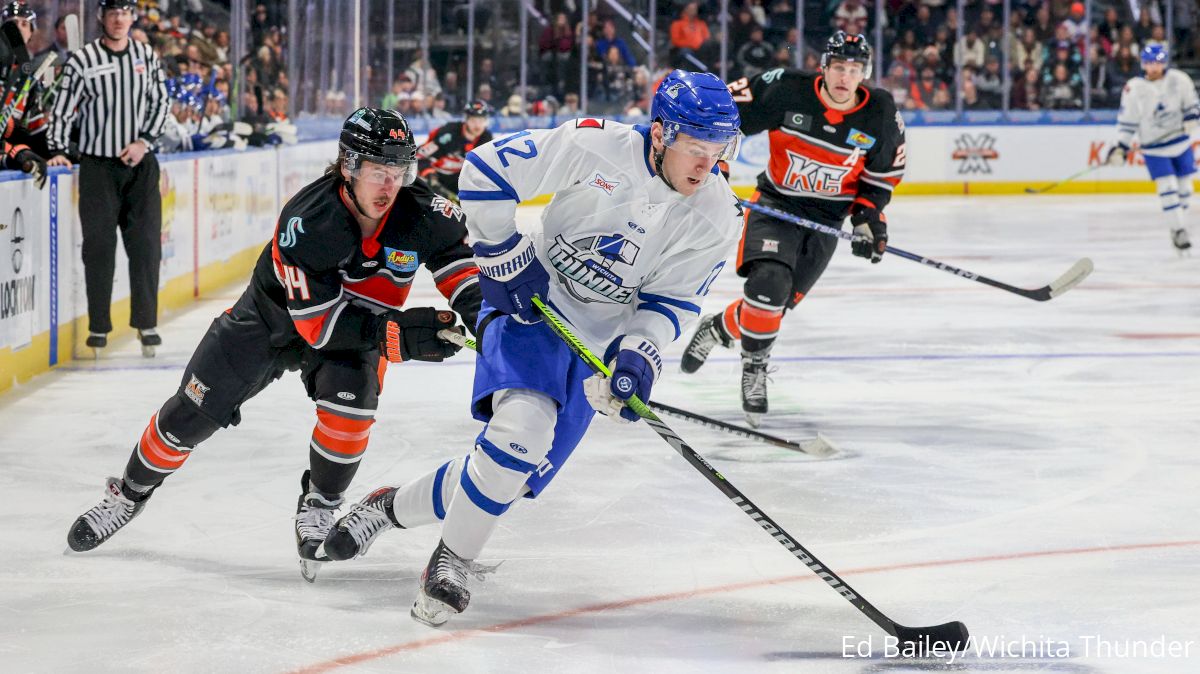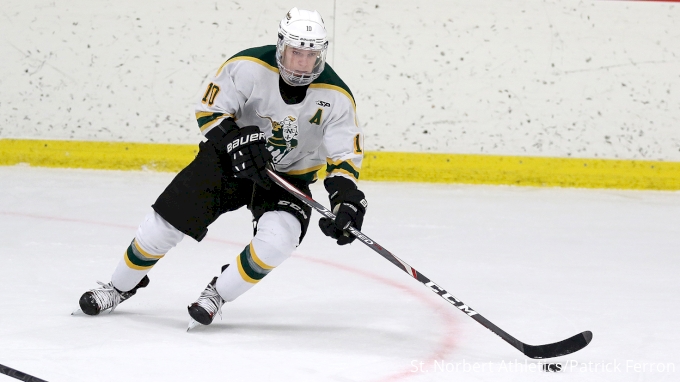Wichita's Peter Bates Paving Way In ECHL For NCAA Division III Players
Wichita's Peter Bates Paving Way In ECHL For NCAA Division III Players
When Peter Bates was leaving junior hockey at age 20, he didn’t think pro hockey would be in his future. Now, he's a standout for the Wichita Thunder.

When Peter Bates was leaving the junior hockey ranks at age 20, he didn’t think professional hockey was something that would be in his future.
“Definitely not,” he said. “It was not really on my radar. I was just happy being able to go to school to continue playing hockey. It didn’t really matter what level I’d be playing at, I just wanted to keep playing at the highest level that I could. I just enjoyed playing hockey with my friends.”
The school was St. Norbert College, an NCAA Division III institution in De Pere, Wisconsin, where Bates landed in 2017 assuming he’d get an economics degree and then find a job in the business world.
He got the degree, but his business has become lighting it up in the ECHL and, perhaps, helping eliminate any stigma against small-college players.
“It’s good hockey, and it takes a lot to go play Division III hockey for four years, continuing to get better and improve yourself,” said Bates, now 27, who has 18 goals and 41 points – third in the ECHL – through 33 games for the Wichita Thunder.
ALL STAR BEHAVIOR ?
— Wichita Thunder (@Wichita_Thunder) January 6, 2024
? Peter Bates
? Brayden Watts
? Jeremy Masella pic.twitter.com/fYYfkEarxS
The native of Evanston, Illinois, will compete Monday at the ECHL All-Star Classic in Savannah, Georgia, where a team of the ECHL’s best players will face the host Ghost Pirates at Enmarket Arena.
“Division III kids may not have the most talent, but we all know what it’s like to be on a team and know what it’s like to be on a team at all different levels,” Bates continued. “Sometimes, you’re the best player, sometimes you’re not the best player. I think that’s probably the one big thing I’ve noticed about Division III people, they’re pretty flexible and can do a lot of different things that you need them to do. You just ask them.”
As Bates spoke about NCAA Division III players, it got me thinking back to a one I covered with the Fort Wayne Komets: Lincoln Kaleigh Schrock.
Like most people, I operated under the assumption for a long time that the rookies worth knowing about all came from Major Junior or NCAA Division I hockey. Then I started to hear rumblings in 2009 that the Komets, then in the International Hockey League, were thinking of signing Schrock after he’d captained Neumann University to the NCAA Division III national championship.
In fairness, Schrock was from Fort Wayne, Indiana, and everyone secretly wanted him to make the team. But it became apparent immediately that he had a huge level of grit, determination and joy that guided his game, and he scraped his way into a roster spot, then helped the Komets to championships in the IHL and Central Hockey League.
Schrock carved a niche as an energy forward, great on defense and willing to fight, but versatile enough to play on the top line. He’s probably the only team captain I’ve seen who sometimes was the spare forward, only getting a handful of shifts. But he taught me not to underestimate small-college guys.
And Bates is someone teaching others that, too, though he’s done it by scoring in bunches.
“I think there’s a different mindset coming from Division III,” said Bates, 6 feet, 185 pounds. “I can’t speak for Division I or Major Junior people, but in Division III, you’re just trying to win and play hockey with your friends. It’s all about, ‘How can you help your team win? How can you do well as a team?’ It makes you play hockey with a different mindset than if you’re trying to play pro. (If you are,) you might be a little more focused on yourself and what you can do better to improve your own game. When we went to college, it was all about, ‘What can you do to make your team better?’”
Bates showed some inklings in juniors of the offensive potential he had.
Skating in the North American Hockey League during the 2016-2017 season for the Janesville Jets, he totaled 24 goals and 56 points in 58 games. That’s when he caught the eye of a coach just down the road, St. Norbert’s Tim Coghlin.
Bates’ mentality about his future started to gradually change after his freshman year, 2017-2018, when St. Norbert won the national championship. He then saw teammate Tanner Froese make it to the ECHL. The next year, Riley Christensen made it to the Southern Professional Hockey League.
“It kind of gets in your mind that you can do it, too, if you work as hard as they did,” Bates said. “So, then you start working hard. And I was in school for five years because of COVID, so I had an extra year, and that probably helped my chances of continuing playing, just being able to get that extra year to get better.”
Bates was at St. Norbert until 2022, totaling 65 goals and 157 points in 123 games. He went to three NCAA Tournaments, won two Northern Collegiate Hockey Association playoff titles and won one regular-season title.

In his final season, he led all NCAA Division III players in scoring with 28 goals and 58 points in 31 games. He won the Sid Watson Award as the best player in NCAA Division III, according to the American Hockey Coaches Association, and he was a two-time NCHA Player of the Year.
He’s certainly not the only NCAA Division III player doing good things in the ECHL.
Others include the Indy Fuel’s Matus Spodniak and Samuel Ruffin, who both played at Adrian College; the Kalamazoo Wings’ Hunter Vorva, who manned the net for Marian University; and the Toledo Walleye’s Conlan Keenan, who played at SUNY-Geneseo.
But Bates potentially has been the best of them.
“He’s a puck-possession forward and a very good all-around player,” Wichita coach Bruce Ramsay said. “He’s played all three forward positions for me this year. Penalty kill, power play, he’s obviously putting up a lot of points and is having a great season. He’s just very, very reliable and is just growing in confidence here.”
Ramsay acknowledged he lucked out a bit with Bates, who began his pro career with the ECHL’s Atlanta Gladiators late in the 2021-2022 season and totaled three goals and five points in 14 games, including three playoff games.
Bates was sent to Wichita, along with defenseman Greg Campbell, in July 2022 to fulfill the trade for defenseman Jacob Graves.
Those transactions can be challenging for coaches and general managers, especially when they come to rookies, because there’s often a limited pool of players to choose from. They may not be familiar names, and sometimes they don’t end up reporting to their new team. But Ramsay did some research on Bates and liked what the stats told him.
Bates had 22 goals and 40 points in 70 games last season for the Thunder and, after attending 2023 training camp with the American Hockey League’s Chicago Wolves, is way ahead of that pace this season.
“I picked the right guy, because sometimes those (future considerations) trades can fall flat on your face,” Ramsay said with a chuckle, before adding that Bates captained the Thunder while Brayden Watts was on paternity leave this season. “(Bates) brings that quiet demeanor to the rink every day, and he just competes.”
Bates has done some of his best work with Michal Stinil, who has 11 goals and 28 points in 28 games this season, but Bates hasn’t really had consistent linemates because of injuries and much movement of players between the Thunder and the AHL’s San Jose Barracuda.
A breakout season has earned @Wichita_Thunder forward Peter Bates a spot in the 2024 @ECHL All-Star Classic later this month.
— Taylor Eldridge (@tayloreldridge) January 4, 2024
Here's what the 27-year-old former D3 star said about why things are clicking this year for him in Wichita.https://t.co/K1IIyP0qcz
For Wichita’s third-ranked power play (26.5%), Bates has been productive, tallying five goals and 15 points.
The Thunder are off to a rough 10-19-4 start, though, and have lost their last six games. In fairness, Wichita has faced the Kansas City Mavericks and Idaho Steelheads – two of the ECHL’s top teams – a whopping 11 times and gone 1-9-1.
“Losing weighs on you,” Bates said. “It’s your job to go out and win, so it’s definitely tough when you’re not winning. It feels like you just can’t find a way to win, and it’s definitely been tough.”
Bates admitted that the adjustment from NCAA Division III to the pros was substantial, “definitely intimidating,” but that’s natural.
Major Junior and NCAA Division I players have played something closer to pro hockey – big crowds, nice amenities, large coaching and training staffs, better equipment – and it’s got to be a shock to the system going from a small Wisconsin college to a league just two tiers from the NHL.
As Bates’ confidence has flourished, so has his game. This isn’t to say any NCAA Division III player could do it, but doors are opening.
“You have to find the right ones,” Ramsay said. “There are few and far between still that can play at the ECHL level, but there are a lot of Division I players who aren’t capable of playing at the ECHL level. It’s pretty damn good hockey. (Bates) has come in and proved that he’s not just good enough to play in this league, he definitely would not hurt you if he got called up and got an opportunity in the AHL.”
Even if there isn’t a big influx of NCAA Division III players, Bates is proof of something else that is being embraced across the league – the value of older rookies coming out of college hockey.
“It’s a big step from Major Junior. You notice it,” Ramsay said. “You have to be an elite Major Junior player to (go directly to the ECHL). If you’re not, it’s tough. You’re 20 years old and playing against 16-, 17- and 18-year-olds, and all of a sudden, you move up to the ECHL, and you’re playing against guys in their late 20s and 30s, and they’re men.”
There are 20-year-old prospects making noise in the ECHL, though.
Fort Wayne has Jake Chiasson, an Edmonton Oilers prospect. Idaho has Francesco Arcuri, a Dallas Stars prospect. Savannah has Joe Fleming, a Vegas Golden Knights prospect. And the Norfolk Admirals have Thomas Milic, contracted to the AHL’s Manitoba Moose.
Bates, however, is a great example of what seasoning in college hockey can do for a player. And he’s shown that players coming out of college around age 25 can be trusted with great responsibility as leaders early in their pro careers.
“I cannot imagine trying to play professional hockey at age 21,” Bates said. “It was hard enough to be a freshman in college. It’s impressive the people who can do it. We have a couple guys on our team who are pretty young, and one of them (21-year-old defenseman Lleyton Moore) got called up (to the AHL’s Tucson Roadrunners). It’s impressive how good he is at that age.”
Bates also has been impressive, and the Thunder will need him to remain so, if they’re going to get back in the playoff race.
“We have the potential to have a very good hockey club here,” Ramsay said.